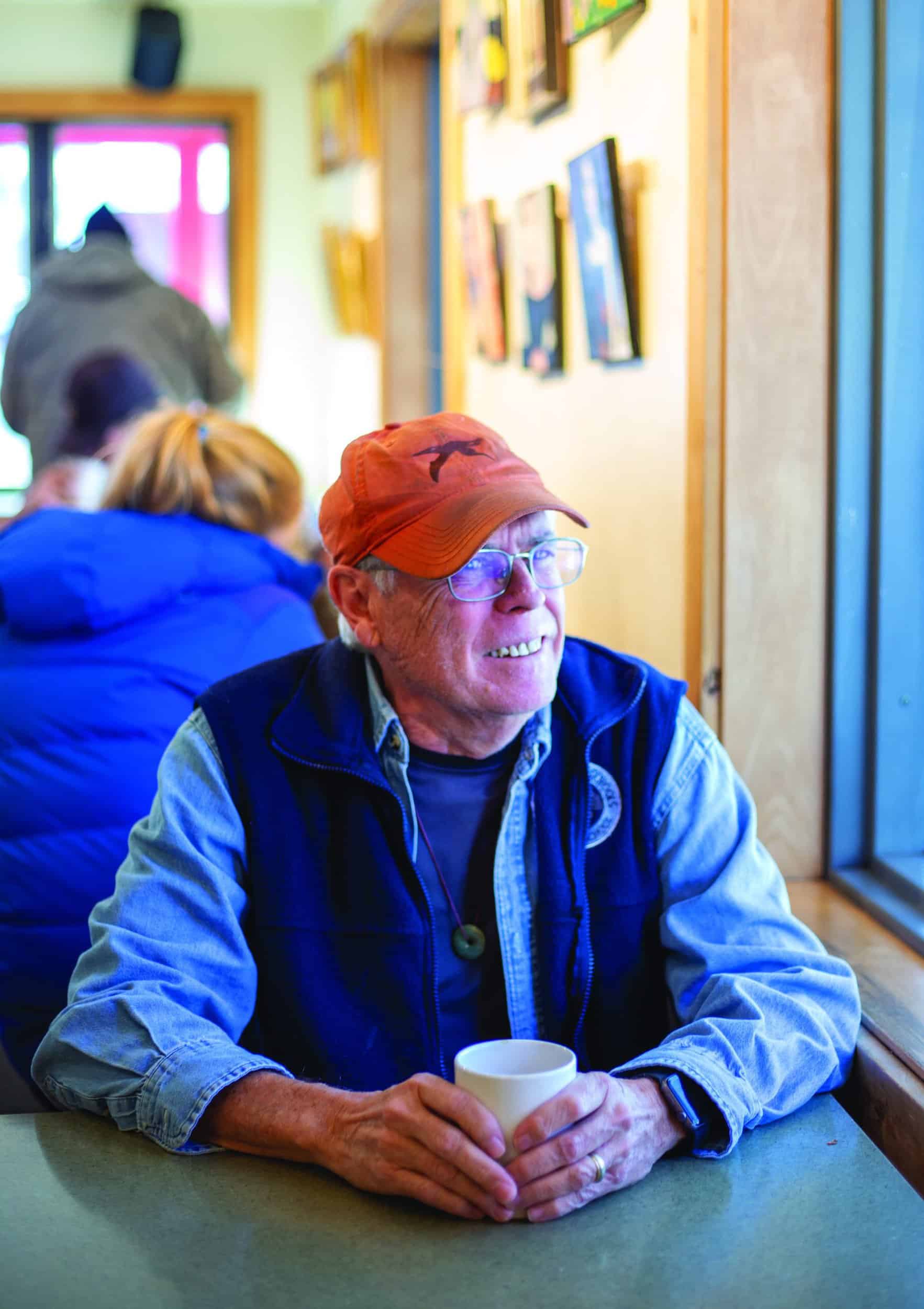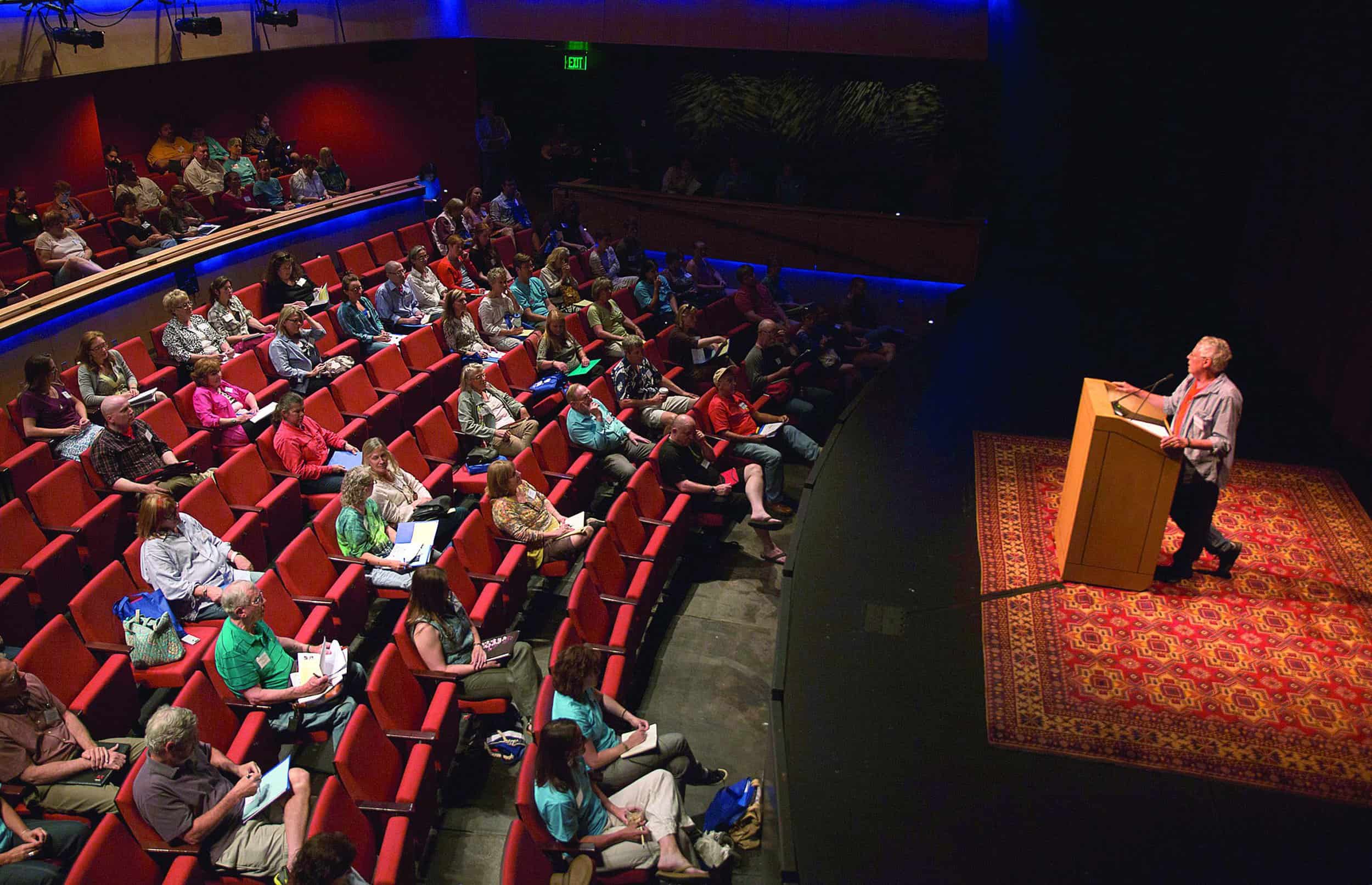Read The
Current Issue
Tim Sandlin
Even better than this Jackson-based novelist’s books might be the writing community he helped create.
// By Whitney Royster

In 2016, Peter Aguero, the host of The Moth, a national storytelling platform, came to the Center for the Arts stage, and announced, “Yeah, I’m crying” to a packed, $75-per-ticket crowd. The reason? Earlier that day, he had discovered one of his boyhood heroes, Jackson resident and prolific author Tim Sandlin, worked at the front desk of the town’s famous arts building. “Do you guys know how lucky you are?” he asked The Moth crowd.
Had Sandlin heard about this? Yes, he had, and he shrugged it off with humility. “People see me on the desk here, and they don’t know who I am,” he says. “I’m like the bottom guy in the whole town with this entry-level job, but I’m the only one with a fan club.” His “Sandlinistas”—fans of his 10 novels, two books of columns, screenplays, and other writing—follow him at timsandlin.com. (Sandlin does say Sandlinista membership is not as robust as it was when he was writing his widely enjoyed “GroVont Trilogy” in the early and mid 1990s.)
Sandlin’s first novel, Sex and Sunsets, was published in 1987. Since then, he has garnered acclaim with the GroVont Trilogy (Skipped Parts, Sorrow Floats, and Social Blunders), Honey Don’t, Rowdy in Paris, and Jimi Hendrix Turns 80. Three of Sandlin’s books have been made into movies. In 2022, his latest collection of columns—most of which first appeared in Jackson Hole magazine—Somewhat True Tales of Jackson Hole, was published. What’s most striking about Sandlin’s 35-plus years of writing about Jackson Hole is this: much of the content doesn’t change.
Then and now, characters bemoan the housing crisis and cold Jackson winters. Global warming comes up, as do guns and clueless tourists. Sandlin admits he’s been writing about Jackson Hole for so long, he steals from himself. “There are so many ongoing battles,” he says. “Like, ‘Are you a real local?’ I came here in ’59 and I wasn’t born here, so no, I’m not.” That conversation, too, comes up in his novels. “I trashed rich people a lot,” he says. “I was one of the first ones to say the billionaires have driven out the millionaires.”
Sandlin can also map some of the valley’s cultural evolution. The first artists here were the writers, the biologists, and nonfiction writers. Diary of a Dude Wrangler by Maxwell Struthers Burt put Jackson Hole on the map, and the area became a place where critics would gather in the summer and drink around the campfire. In the 1960s, there was one radio station and one movie theater. “Cable TV changed everything,” Sandlin says. Before, people had the annual “Pothole Festival” where you submitted the gnarliest pothole to the newspaper for voting. (“The chamber of commerce shut that down,” he says.) “You had to really want to be here,” Sandlin says. “Now it’s easier.”
In his time here, Sandlin has had what he guesses to be 40 entry-level jobs, from skinning elk to driving an ice cream truck, gardening for the Rockefellers, and dishwashing. In 1972, he slept under the grandstands of the Grand Teton Music Festival in Teton Village and woke up when the orchestra started playing. Sandlin has slept on the front porch of the secondhand shop Browse ‘N Buy, and in a barn near Taggart Creek. “I knew people who rented a bed in an apartment where you would come in from work at 7 a.m. and kick someone out,” he says. “It seemed just as bad. In the early 1970s, people lived on forest service land in tents. I had a teepee. I always liked that better than seven people in an apartment.” He wrote every day for 20 years before meeting another writer.
“You had to really want to be here. Not it’s easier.”
Tim Sandlin
And then Sandlin, the late John Byrne Cooke, and Debbie Bedford began informally meeting. Those informal meetings grew into the Jackson Hole Writers’ Conference, which Sandlin is now directing into its 31st year. “It was cool once a year to talk to someone you had something in common with,” he says. “I didn’t ski or sell real estate so I wouldn’t have anyone to talk to.”
The Jackson Hole Writers’ Conference has had more people go on to publish books than any other conference per capita, Sandlin says. Past attendees include Kyle Mills (who went on to become a number-one New York Times bestselling author; he writes thrillers) and Shawn Klomparens (the author of three books). “I taught a novel-writing class where 7 out of 10 went on to publish their books,” Sandlin says. “It took a long time, but it’s an amazing ratio.”
Today he’s committed to the organization’s success both as a jumping-off point for writers and a community touchstone.
Building that connection in the writing community has kept Sandlin from becoming bitter as Jackson grapples with changes. “The longer you live in Jackson, the less people you know,” he says, attributing the sentiment to the former state representative H.L. Jensen (who shows up in his books). “Once you get out of those jobs where you’re in restaurants and bars, people leave. I know a lot less people now.”
Still, there have been changes for the good. The Center for the Arts opened in 2008 and today is home to 22 arts-related nonprofits, in addition to the Center Stage, Black Box Theatre, classrooms, and studios. “This building has been a second home since it opened,” Sandlin says. “We all take care of each other in here. The cooperation and collaboration has been really amazing. The Center itself is trying to help us survive.” Sandlin also loves the National Museum of Wildlife Art and the Grand Teton Music Festival. Sometimes these things collide, like when a GTMF quartet plays on the Center for the Arts lawn in summer.
And there are local artists who inspire him. “There’s a new generation coming up,” he says. “Andrew Munz, Molly Loomis, Katy Fox, and Matt Daly. I like a lot of the work they’ve been doing.” He’s also inspired by the people who come and go from the Center for the Arts. “There are a lot of people who think you have to be a millionaire to come in this building,” he says. “From working here, it’s not true. Those organizations (in the building) will get you into a class. The whole [Center] elitism thing is inaccurate.” Sandlin is impressed by the ceramic artists. “I watch them when I’m on the front desk,” he says. “[They] are such fanatics. They are in there like every day. I work on Sundays, and when I get here, they are waiting for me in the parking lot, and when I leave they are still here.”
While he enjoys watching artists coming and going at the Center, Sandlin himself visits rocks and streamsides to keep writing. “I watch the sky and I watch the sun come up and go down,” he says. “I figured out once the number of full moons I’ve seen in Jackson Hole. It’s about 1,600.” JH





